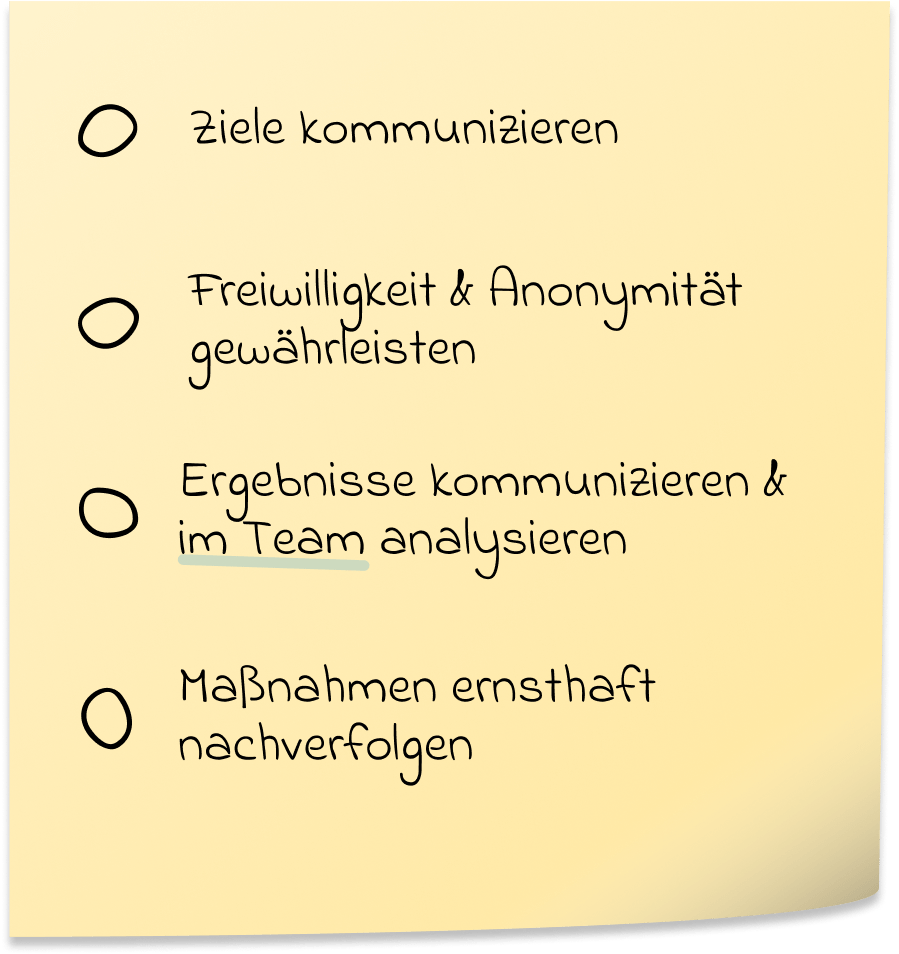An employee survey can provide a solid basis for improving the employer brand and ensuring employee satisfaction. Provided that the employees take part in the survey and are willing to give their honest feedback. So, employee survey anonymous or not?
In practice, this is often difficult and the desired participation rates of 70-80% from benchmarks seem a long way off. A classic method: shortly before the end of a survey period, a reminder is sent again in order to achieve the targeted participation rate in the final sprint. However, these memories will not help if the following points are missing:
Employee survey anonymous or not?
If the workforce is unsure whether anonymity is guaranteed in the employee survey, or if they are even concerned that their honest feedback could have negative consequences for them, there is no basis for successful employee participation (Edmondson, 2004). In this respect: The trend should be kept anonymous.
But if you have the impression that the employees would not mind storing their names: Why not just find out by random sample or in an anonymous survey how the employees see it? And so virtually let the employees decide for themselves whether the survey should be anonymous or not.
To ensure the basis of trust, the goals of the survey should be made transparent in advance and managers should emphasize both the goals and the voluntary nature of the survey. For more tips on how to create a psychologically safe atmosphere, you can visit our Psychological Security Article .
Generate motivation to participate in the employee survey
The next step is to make sure that the workforce is motivated to take the survey. It is crucial here that your feedback meets a serious intention to improve the company. This can also only be communicated via early communication & #8211; For example, through an authentic video message from the CEO, parallel to an equivalent note from the manager in the next team meeting.
Of course, it is problematic when experiences from previous, similar measures have shown employees that nothing ever really changes afterwards. Against the background of the feeling that nothing is happening anyway, employees often find it difficult to get up and take the time to answer comprehensive questionnaires.
Employee survey anonymous or not? Probably the most important thing: Initiate noticeable changes
In order to ensure that the participants of an employee survey feel understood, the question could also be included
Have goal-oriented measures been derived from the results of the last employee survey?
This question should appear in an employee survey
If an employee survey is perceived as a pure data collection, the motivation to contribute to it is rather low. Employee-centered follow-up processes should therefore be an integral part of every employee survey (Church, Golay, Rotolo, Tuller, Shull & Desrosiers, 2012).
Of course, this also means that employees receive feedback on results and are also involved in the derivation of measures. One format that lends itself here is the so-called Retrospective (short: retro), which comes from the agile methodology. In a retro, you examine the current challenges of the team for core causes and jointly record optimizing measures. You can also find more information on the topic of retros right here.
In order for the above question to be positive, one should not stop at this step. The measures initiated must also be subjected to an evaluation so that the workforce can report whether the situation has improved (Müller et al., 2007).
Conclusion
Even if reservations about an employee survey are removed, it is anonymous, etc., this is still not a guarantee of a good participation rate. The manager in particular plays a decisive role in that Involve team members in the processto ensure that the feedback bears fruit and increases the motivation of the workforce to participate.

This process naturally demands a lot from executives: they have to share their interpretive power over the results with the teams and even have to be challenged later regarding the target orientation of the measures. An appropriate leadership culture must be established so that managers can find their way in this role.
You can find out which approaches exist to implement the philosophy of Agile Leadership and to support executives in this role in our role Article on executives in a new work context!
"Employee survey anonymous or not?" - Sources
Church, AH, Golay, LM, Rotolo, CT, Tuller, MD, Shull, AC, & Desrosiers, EI (2012). Without Effort there can be no Change: Reexamining the Impact of Survey Feedback and Action Planning on Employee Attitudes. Research in Organizational Change and Development, 223-264.
Edmondson, AC (2004). Psychological Safety, Trust, and Learning in Organizations: A Group Level Lens. In Kramer, R. & Cook, K. (ed.), Trust and Distrust in Organizations: Dilemmas and Approaches (S.239-272). New York: Russell Sage Foundation.
Müller, K., Straatmann, T., Racky, S., Bladowski, B., Madukanya, V., Winter, S., Jonas-Klemm, S., Hodapp, M. (2007). Shaping follow-up processes in concrete terms: follow-up instruments. In: Bungard W., Müller K., Niethammer C. (ed.), Employee survey & #8211; so what…? Successfully designing the MAB and follow-up processes (p.109-178). Heidelberg: Springer.








